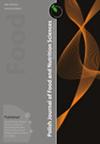Distribution of Mycoflora and Assessment of Moisture Content Measurement Methods of Indian Bakery Food Products
IF 2.3
4区 农林科学
Q3 FOOD SCIENCE & TECHNOLOGY
引用次数: 0
Abstract
: Mycotoxins are toxic food pollutants that are created naturally by some fungus. By contaminating food, they have a harmful impact on human health. This study's major objective was to simulate food products from bakeries being contaminated. Separate bakery food samples were examined to see whether fungus and associated mycotoxins were present. One hundred fifty-nine (159) bakery food samples were collected randomly from different shops in rural sides and around Davangere city, during July to November 2022. Qualitatively, maximum number of molds were isolated and identified from bakery food samples. The most common species are Trichoderma harzianum , A. niger, Rhizopus , A. flavus , Penicillium sp , Curvularia sp , A. parasiticus , Penicillium chrysogenum , Aspergillus sp , Fusarium sp , Trichoderma sp , Alternaria sp and Mucor sp . The moisture content was found to be maximum in sweets made from dry fruits and milk followed by cakes, burfi, cookies, bread etc and minimum growth were observed in chips. Results regarding moisture content of bakery food products showed that, NS41-NS159 samples had high moisture content 60%, followed by NS1-NS11 (49.8%), NS12-NS20 (49.8%), NS21-NS35 (37.8%) and NS36-NS40 (13.6%) respectively. Results in moisture content determination in bakery food products reveals that high moisture content causes maximum growth of microorganisms on bakery food samples. Statical analysis showed that storage had a significant effect on moisture content of bakery food products.印度烘焙食品菌群分布及水分测定方法评价
真菌毒素是由某些真菌自然产生的有毒食品污染物。通过污染食物,它们对人体健康有有害的影响。这项研究的主要目的是模拟被污染的烘焙食品。对单独的烘焙食品样品进行了检查,以确定是否存在真菌和相关的真菌毒素。在2022年7月至11月期间,从农村地区和达万热市周围的不同商店随机收集了159份烘焙食品样本。定性分析,从烘焙食品样品中分离鉴定出最多数量的霉菌。最常见的种类是哈茨木霉、黑霉、根霉、黄霉、青霉、曲霉、寄生霉、青霉、曲霉、曲霉、镰刀霉、木霉、互交霉和毛霉。由干果和牛奶制成的糖果的水分含量最高,其次是蛋糕、burfi、饼干、面包等,而薯片的水分含量增长最少。烘焙食品的水分含量结果显示,ns41 ~ ns159样品的水分含量最高,为60%,其次是ns1 ~ ns11(49.8%)、ns12 ~ ns20(49.8%)、ns21 ~ ns35(37.8%)和ns36 ~ ns40(13.6%)。烘焙食品中水分含量的测定结果表明,高水分含量会导致烘焙食品样品中微生物的最大生长。统计分析表明,贮藏对烘焙食品的水分含量有显著影响。
本文章由计算机程序翻译,如有差异,请以英文原文为准。
求助全文
约1分钟内获得全文
求助全文
来源期刊

Polish Journal of Food and Nutrition Sciences
FOOD SCIENCE & TECHNOLOGY-
CiteScore
4.30
自引率
12.50%
发文量
25
审稿时长
20 weeks
期刊介绍:
The Polish Journal of Food and Nutrition Sciences publishes original, basic and applied papers, reviews and short communications on fundamental and applied food research in the following Sections:
-Food Technology:
Innovative technology of food development including biotechnological and microbiological aspects
Effects of processing on food composition and nutritional value
-Food Chemistry:
Bioactive constituents of foods
Chemistry relating to major and minor components of food
Analytical methods
-Food Quality and Functionality:
Sensory methodologies
Functional properties of food
Food physics
Quality, storage and safety of food
-Nutritional Research Section:
Nutritional studies relating to major and minor components of food (excluding works related to questionnaire
surveys)
-“News” section:
Announcements of congresses
Miscellanea
 求助内容:
求助内容: 应助结果提醒方式:
应助结果提醒方式:


